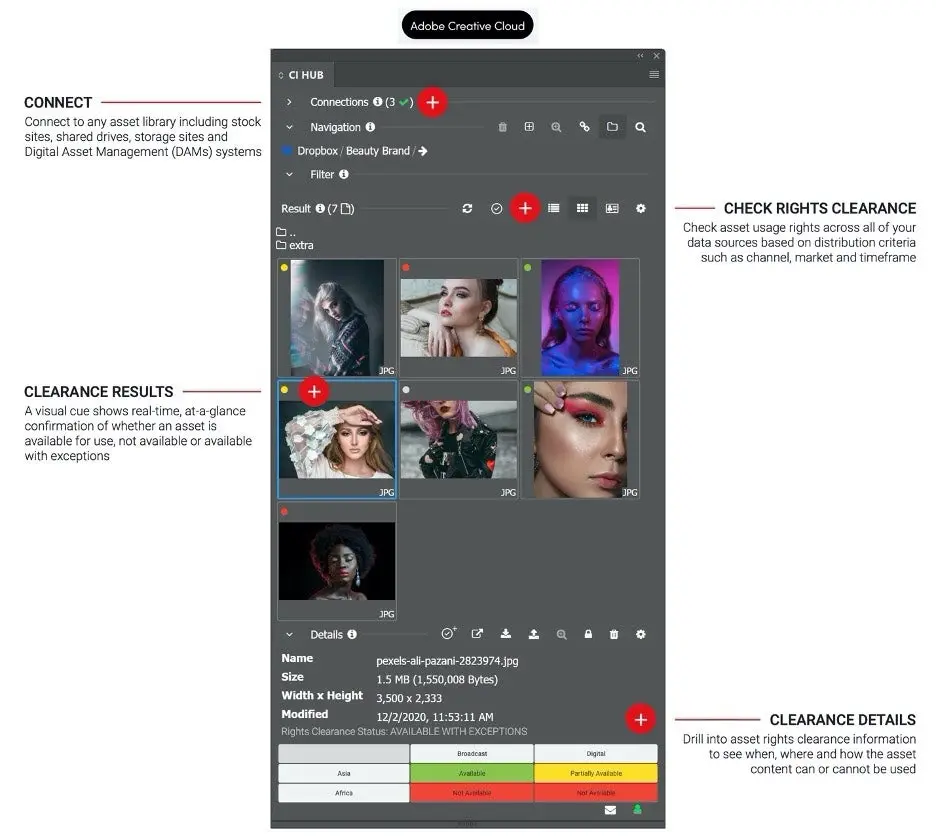How to “Know Your Asset Rights” early on during the creative process

CI HUB connector integrating Adobe Creative Cloud and FADEL Rights Cloud makes knowing Asset Rights within InDesign, Photoshop, Illustrator, Premiere Pro simple.
The goal for marketing creatives — whether working for an agency or inhouse — is to tell the story of your company, brand or product through the power of creative content. You create your “art” with the intent to convey messages that best communicate with the desired audience.
However, in executing on this campaign vision it is essential to “Know your Rights” so that you do not compromise the brand image, nor put your brand at risk. As content proliferates and new channels emerge, there are more limitations on how you can use, where you can use and when you can use content. Would you rather confirm asset usage rights during the creative process to ensure that you are using assets with the right “rights” or find out about post-distribution misuse with a hefty lawsuit?
Contents
Why is it challenging to “Know your Rights”?
A piece of marketing content may include licensed elements such as photos, illustrations, music, video and voiceover — all with a different set of rights and restrictions as defined across any number of contracts:
It may include commissioned work from a photoshoot with models and photographers. Ideally you have full distribution rights from all talent, but the likelihood is that you do not. Terms of use are often more granular for celebrities.
It may include stock assets that are governed by corporate contracts.
It may include corporate branding such as fonts, logos, product packaging and corporate imagery where it is essential to use the latest approved assets.
With content elements and talent being governed by varying contracts it can be extremely complex to decipher what can be used across the desired distribution of channels, markets and timeframes.
If I can download it, I can use it, right?
Wrong. Just because an asset can be downloaded from a stock site or shared drive or company Digital Asset Management (DAM) system does not mean that you can use it.
Most large marketing departments have governance policies for checking asset terms of use, whether through manual processes such as reaching out to legal, reviewing contracts or cross-checking spreadsheets or automated processes with Digital Rights Management software. Some companies will lock down assets based on rights or users, but many require creative teams to be more accountable for the valid use of their work.
Why worry about Digital Rights Management (DRM) during the creative process?
Waiting to check content element rights after the creative is completed might cost you, your agency and your brand. By taking DRM seriously during creative and production you can:
Ensure compliance — If you are doing work for a large organization then compliance will be a serious matter, both brand compliance and usage compliance. With brand images being highly cultivated and designed, it is important that the wrong assets are not floating out there in the ether misrepresenting your company. And of course you do not want your company to face litigation due to the misuse of content or the use of expired content.
Eliminate re-work — According to MarTech Advisor, “Most delays in projects can be attributed to tangles in review and approval process. 92 percent of marketers confess to being victims of this phase.” Often this review process will include confirming the rights associated with the content and content elements. Finding out that there is a non-compliant element is a costly mistake that can lead to firefighting and last-minute rework.
Protect your brand — Misuse can cost millions in penalties, but the negative press associated with a lawsuit may be even more damaging to the company. Tarnishing your reputation can lead to hampered customer relations, a damaged brand image, and a loss of sales or clients.
How do I “Know the Asset Rights”?
“At CI HUB we know about the struggle with DRM firsthand and how it hinders the process of creating new content. For us it was clear that we would have address this challenge for our customers and find a solution to implement into our CI HUB Connector for Adobe Creative Cloud and Microsoft Office 365,” said Andreas Michalski, CEO of CI HUB. “After an intensive process of evaluating different tools and products, we found FADEL, experts in DRM. With the implementation of FADEL Rights Cloud into our CI HUB Connector for Adobe Creative Cloud and Microsoft Office 365 we created the perfect solution to face the DRM challenge — right in the product you work in.”
With the integration of FADEL Rights Cloud into the CI HUB Connector, you can, within the Adobe tool you are using, connect to any data source including stock sites, shared drives, storage sites and DAMs, find your desired assets, and check asset rights against the distribution plan. The solution delivers visual alerts on “if” and when, where and how your assets can be used. You no longer have to leave the tool or check a database for the assets´ rights.
The integrated solution for Adobe Creative Cloud empowers you to gain “rights” information at your fingertips. As a creative you no longer have to figure out the contractual terms of an asset. Let the powerful combination of Rights Cloud and CI HUB figure it out for you and deliver the answer right to the Adobe Creative Cloud tool you are working in, whether it’s Adobe Photoshop, Adobe InDesign, Adobe Illustrator, Adobe After Effects or Adobe Premiere Pro. Knowing your rights has never been this easy!
Source : Adobe









